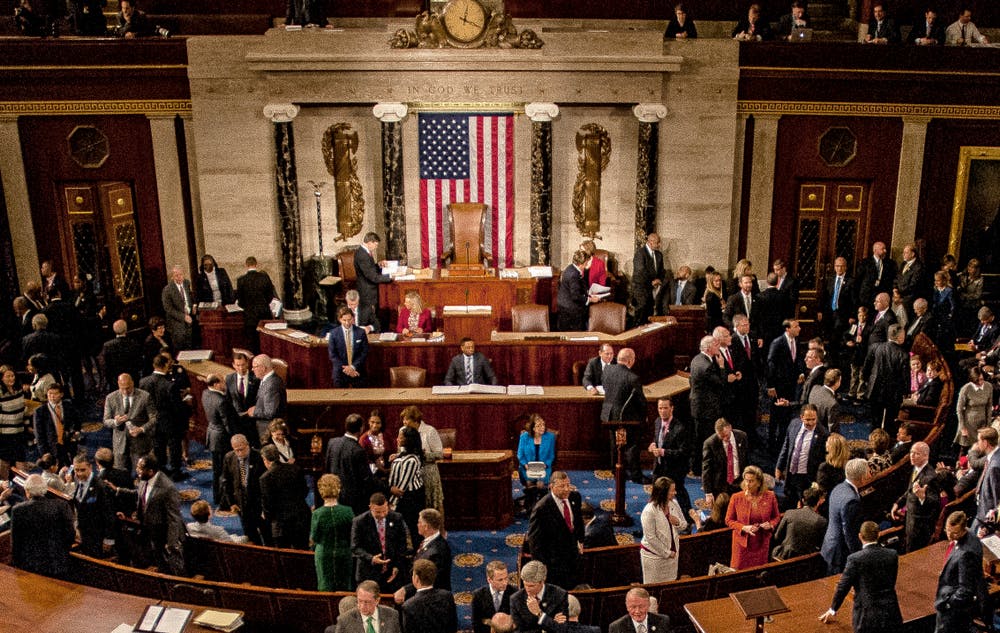We asked six immigration lawyers to share their thoughts on the past year, and the one in front of us. Reauthorization was the big topic. While many think the return of the Regional Center Program could go either way, one lawyer was confident it would arrive this spring. And if the program doesn’t come back, the group had more collective confidence that past investors would be protected with “grandfathering” legislation.First, we at EB-5 Weekly would like to acknowledge that the following article was made possible by the contributions of the following immigration lawyers: Joel Yanovich, Andy Semotiuk, Phuong Le, Natalia Polukhtin, Robert Gaffney, and Michael Harris. And while none has an inside track in Congress, their collective experience in EB-5 should make readers strongly consider the possibilities they present.
Looking back at 2021
EB-5 lawyers react to what happened — or didn’t — with reauthorization
The EB-5 industry, and investors around the world, had three opportunities in 2021 to expect — or at least hope for — reauthorization: June 30th, the program expiry date; October, the beginning of the fiscal year; and early December, when spending legislation was expected to pass, providing a vehicle an EB-5 bill could attach to.All three “deadlines” came and passed without the legislation many hoped for. How do the lawyers we interviewed feel about this?The failure to extend the program before the June expiry date surprised Andy Semotiuk: “It seemed impossible for the U.S. not to reauthorize the program in some way given the tremendous investments the program was bringing in every year.”While Phuong Le was more “frustrated and disappointed” than surprised, he shares a similar perspective with Semotiuk about the impact of the program: “The economics and stakes all but dictate it [reauthorization].” Le’s steadfast belief in this outcome gives him the patience to endure the program lapse. “I'd rather wait a little longer to have a program that benefits everybody long term than to capitulate and get a program that's unworkable.”But not everyone thinks the hold-out has been wise. Natalia Polukhtin offers a different perspective on waiting for a better deal: “June 30th, and once again, December 3rd, should undeniably have a sobering effect on the EB-5 community. It might be indicative of legislature getting worn out by the constant rural-urban rivalry, when, in fact, efforts should have been allocated into saving the program altogether.”
How did EB-5 investors react in 2021?
Investors in 2021 had to deal with not only the lapse of the Regional Center Program, but the effects of the pandemic on EB-5 processing. Many turned to their lawyers for answers.“COVID made processing grind to almost a dead halt, adding a lot of stress to our relationships with investors who were confused by what was happening, and with USCIS in terms of our expectations for processing applications,” says Semotiuk. “Comforting clients and reassuring them thatAmerica will not let them down became a regular feature of my practice.”Once the Regional Center Program lapsed, many investors were frustrated with having their petitions in limbo. Polukhtin tells us that for nearly every week since program expiry she has dealt with an investor asking who they can sue and why they are not suing yet.“Investors have substantial capital precisely for the reason they feel cheated by the system right now — they like playing by predictable rules and they do not hesitate demanding the partner to stick to those rules,” she tells us. “When (or if) the program gets reauthorized, it will definitelytake significant time to restore trust and confidence in EB-5 with prospective investors.”
2021 saw the rise of a ‘new breed’ of EB-5 investments
While many regional centers played the waiting game in 2021, many businesses and investors chose to take advantage of the fact that the original EB-5 program — investing directly into a job-creating enterprise — is a permanent program and just as capable of producing Green Cards.The past year saw the rise of what Joel Yanovich calls a “new breed of direct EB-5 investments.” Instead of the historic practice of making direct investments into small, self-run business like fast-food franchises, Yanovich saw immigrants “investing into an existing company, usually one setting up a new entity, that’s trying to expand and directly hire people.”Direct investments filling the void left by regional centers is, according to Le, a “necessary and predictable outcome.” As a lawyer active in structuring direct EB-5 investments, Le is just as open to direct investments — so long as the quality of an individual investment is there. “It’s no different than our regional center days,” he says of the vetting process. “We reject the vast majority of projects that come to us.”
Looking ahead to 2022
Some lawyers aren’t counting on reauthorization: ‘it’s a close call’
While immigration lawyer Phuong Le brims with confidence that the Regional Center Program will be reauthorized — and he’s counting on it happening this spring — many others we spoke with, like Yanovich, think reauthorization is far less than certain. “I’m at best cautiously optimistic,” he concedes. “I’m not resigned to the fact that it won’t be renewed, but I can’t say I’m counting on it, either. Perhaps it’s more likely than not. But it’s a close call.”The idea that reauthorization could go either way is shared by Semotiuk. “At this moment, looking into my crystal ball, I estimate the chance of a reauthorization at about 50 percent,” he says. “However, long ago I learned never to discount America. If I had to bet on it, I would bet that the EB-5 program will be renewed by March 2022.”But Yanovich reminds us that program reauthorization isn’t a priority for Congress and will need to be attached to a spending bill. He sees the passage of a budget in February as a “big if” and provides this cautionary advice: “Even if they pass the bill, there’s no guarantee they put the Regional Center Program legislation in there. That just seems like the most likely opportunity.”Perhaps reauthorization gets pushed into next summer; Michael Harris thinks that’s a distinct possibility. “It is appearing more and more difficult to estimate a time frame for revival of the Regional Center Program. I think it will continue to be tied to other immigration reform measures, which may further delay a reauthorization.I hope it comes back by June 2022.”Veteran immigration lawyer Robert Gaffney won’t play the speculation game when it comes to reauthorization and likened such an exercise to throwing darts in the dark. His refusal to make a prediction reinforces the notion that a springtime reauthorization is far from a given.
If reauthorization doesn’t happen, what are the chances of grandfathering legislation?
If reauthorization doesn’t happen, Yanovich sees it as “almost unconscionable” that Congress would not enact a grandfathering bill to protect investors who made their investment while the Regional Center Program was still authorized.He reminds us that many investors cannot easily absorb the blow of never being processed. “For a lot of people, this was their life savings, this was their dream, and now they’re stuck in this bureaucratic nightmare of getting Congress to do what they should.”The ever confident Le says that in the event the program is not reauthorized, grandfathering legislation is “a no-brainer unless the U.S. never wants another residency by investment program again. It's beyond unthinkable. I have no idea why USCIS is being coy, but it'll happen.”Semotiuk agrees that the U.S. must honor its deals with past investors. “To maintain American credibility with investors worldwide, it is critical that EB-5 investorsbe grandfathered,” he states. To not do so would mean “catastrophe for American credibility with investors worldwide. We would enter a phase of a litigation frenzy.” But litigation may not be the answer. “If Congress doesn’t act, I’m sure there are going to be parties that sue,” Yanovich predicts. “But I don’t know how you win that lawsuit of grandfathering outside of Congress acting. What you’re asking for is USCIS issuing visa numbers that statutorily have been taken away. So I don’t know how you get this done short of Congress acting.” Still, Yanovich remains “cautiously optimistic that at the very least these past investors will be helped out.”
What is the future of direct investments — are they really a ‘game changer’?
Direct EB-5 investments are gaining popularity with investors who aren’t content to wait for the possible return of the Regional Center Program — or the return of higher investments amounts. But are direct investments only getting extra activity now because of the lack of regional center competition?Robert Gaffney sees the popularity of direct investments enduring under two conditions: if the minimum investment amount doesn’t rise above $750,000, and as long as they’re the only EB-5 option available. “If the Regional Center Program is reauthorized with capital requirements the same as for direct investments,” he says, “I would expect direct investments to return to their former position as a small fraction of total investor petitions. A small percentage of investors have always preferred direct investments to investment in regional center projects for a variety of reasons. Those investors will remain in the marketplace unless they are priced out.”But the belief in the dominance of regional center investments isn’t shared by all. Phuong Le sees direct investments remaining competitive even if reauthorization occurs, as long as there are quality projects.Yanovich is even more optimistic that direct investments are here to stay. “I think this whole process has been a game changer. We’re starting to see that perhaps even if the Regional Center Program is renewed, there are going to be a fair number of people pursuing this new breed of direct investments.”There are two reasons why direct investments will be popular indefinitely, says Yanovich: First, many investors are on the fence and want to see a track record of direct investment approvals. Second, direct investments can offer far better returns than regional center investments which, historically, have been a place to “park your money,” he says, “with virtually no return on investment beyond the initial investment.”Harris also sees direct investment activity gaining ground in the future. He proposes there should be an incentive for direct investments: “There is strong merit in creating a minimum investment for direct EB-5 investments that may be different from regional center investments.”
Are EB-5 investment amounts going to rise, and how much?
Besides reauthorization, the other big question the EB-5 world has been asking is what will happen to investment amounts. Twice in the recent past the U.S. government (once during Trump’s tenure and once during Biden’s) has tried to raise the minimum investment amount. Most stakeholders take it as a given that the amounts will rise in the future. But how much?Le sees the minimum remaining at $500,000 in the short term, even immediately after reauthorization. “But it's all but guaranteed to raise in the future. Let's just hope future raises allow the U.S. to remain competitive.”Others see a substantial hike coming. Semotiuk hopes the government learned its lesson after the 80% hike of the Modernization Act froze the market. “I suspect investment will climb, but I am hopeful to only $750,000 which was a numberkicked around in speculation a while ago. Chances for a return to $900,000 are still there, but we have gone through such hard times lately that I would be disappointed if that happened.” Could investment amounts find a middle ground between the current levels and the $900,000 price tag? Harris believes so. “I think it stays at $500,000 for many more months. I have heard many discuss the possibility of an increase to $700,000, which would be half of the increase previously sought.”And for those investors waiting for the Regional Center Program to return, Yanovich offers this caveat: “There’s a risk there. It’s possible that they reauthorize, and they also change the investment requirements simultaneously.”
What could EB-5 processing times be in the future?
For the past few years, as processing times have increased, industry pundits have speculated about future wait times. Will the more immigration-friendly Biden Administration improve EB-5 processing efficiency?Perhaps premium processing may be an answer for some. Gaffney declares, “Current EB-5 processing times are a drag on the usefulness of this visa category. If this is not addressed by the agency, or by Congress through the implementation of premium processing for the full range of EB-5 petitions, we can expect that the courts will continue to find mandamus petitions filed by EB-5 investors taking up space on their calendars.”Logistics, according to Harris, are the cause for inefficient EB-5 processing. “I do not have confidence that the USCIS will resolve its processing backlogs until it modernizes its filing processes from a paper-based system to a digital one,” he comments. “Until then, we will be stuck with a U.S. immigration system that is administered at 20th century processing times, not 21st century times.”The optimistic perspective comes, once again, from Le: “Post-pandemic, post-Trump, and post-Biden, with their stated emphasis on improving quality processing times, it can only go up, right?”
In conclusion: no matter what, EB-5 has a future
So here we are. At the end of a tough year, once more in the fierce grip of COVID-19, filled with uncertainty about the future of EB-5. Lawyer predictions about the future of EB-5 range from confidence to uncertainty.Crystal balls may be cloudy, but even in what would be the worst-case scenario for many — no return of the Regional Center Program — we should pay heed to the words of immigration lawyer Natalia Polukhtin: “Failure to reauthorize the program definitely signifies the end of a big era in the EB-5 industry, but it should not be the end of the story.”







